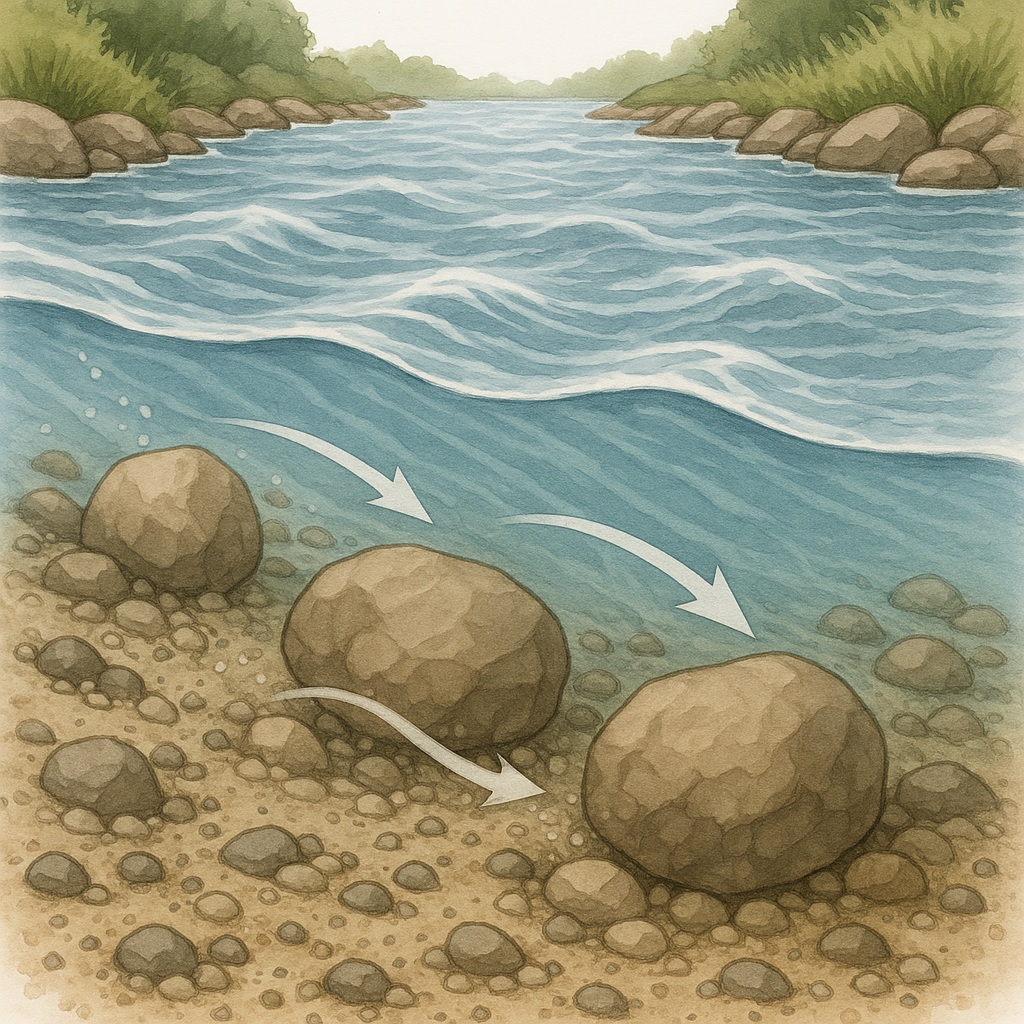Running water is one of the most powerful agents of erosion, transportation, and deposition on the Earth’s surface. Rivers, streams, and rainwater actively reshape landscapes, transport sediments, and create various landforms. Over time, running water plays a major role in sculpting the Earth’s surface through a combination of physical and chemical processes.
Table of Contents
Erosion
Rivers cut into the land using the rocks they carry. This is like nature’s way of sanding down land over time. Erosion happens in four ways:
1. Corrasion (Abrasion): Rock pieces scrape the riverbed and break off more rock.
-
- Lateral corrasion: Wears land sideways → makes valley wider
- Vertical corrasion: Cuts downwards → makes valley deeper
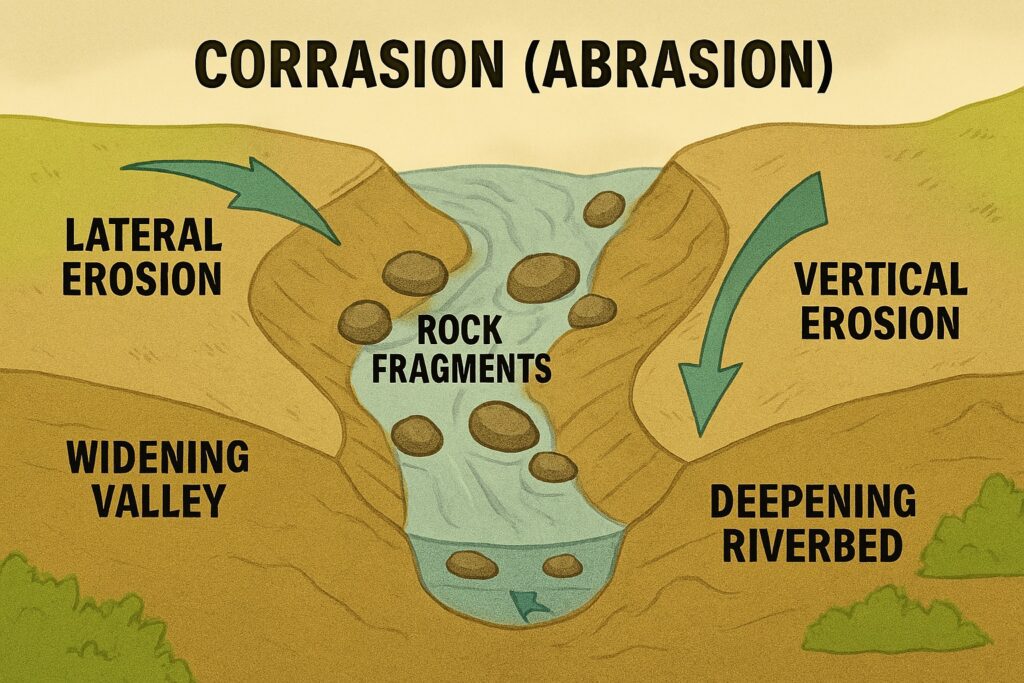
2. Corrosion (Solution): Water dissolves soft rocks like limestone, especially if it has chemicals in it.
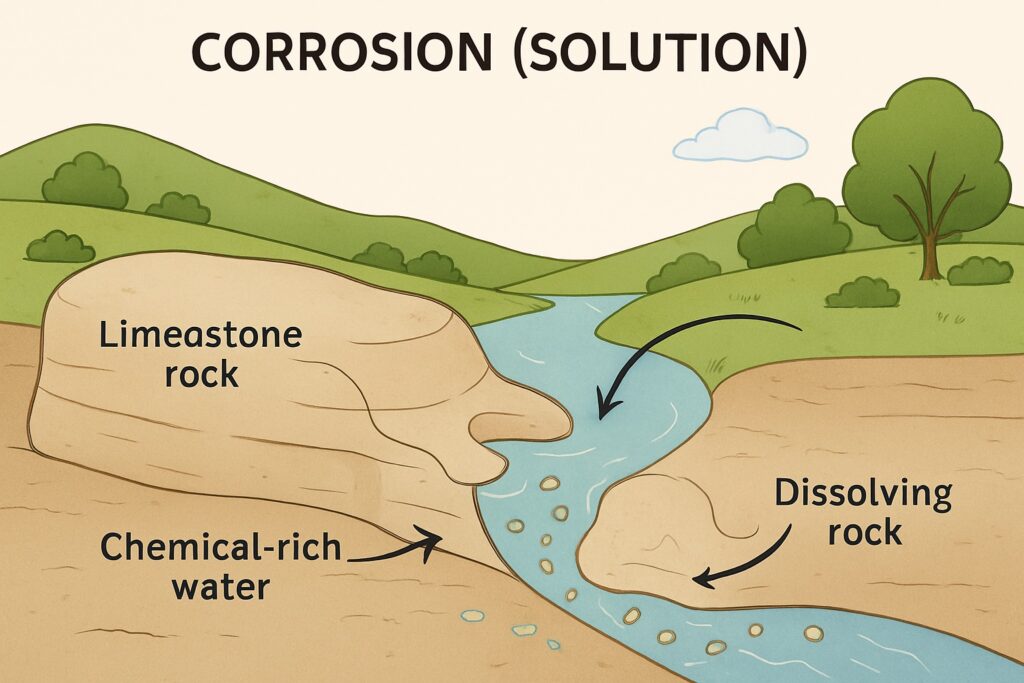
3. Hydraulic Action: Fast-moving water pushes into cracks, loosens pieces, and sweeps them away.
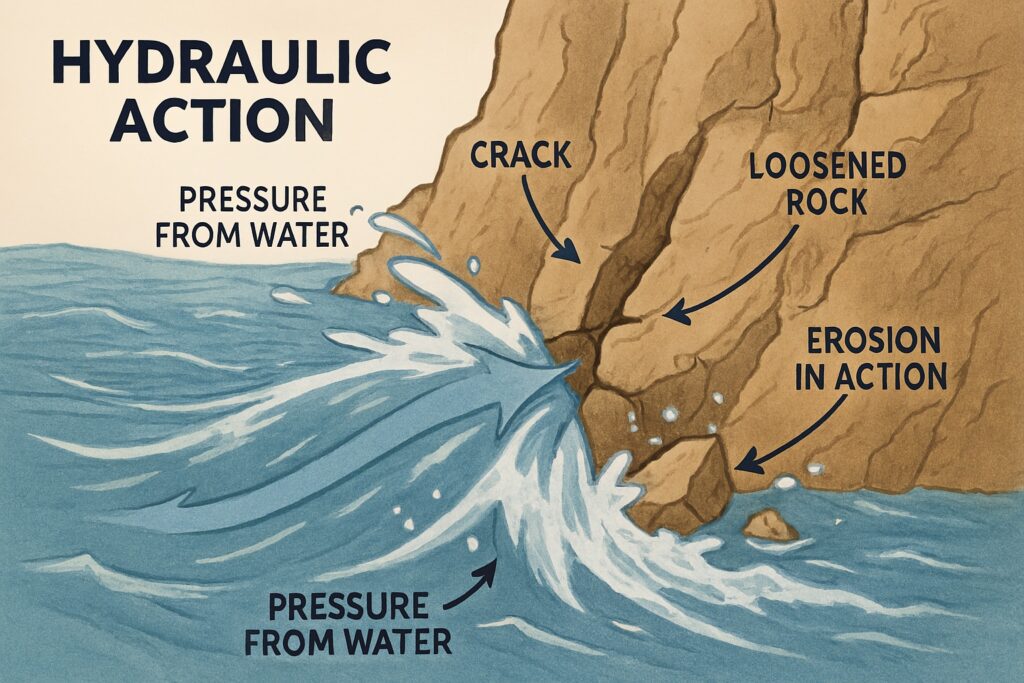
4. Attrition: The rock pieces bump into each other and break into smaller, smoother pieces.
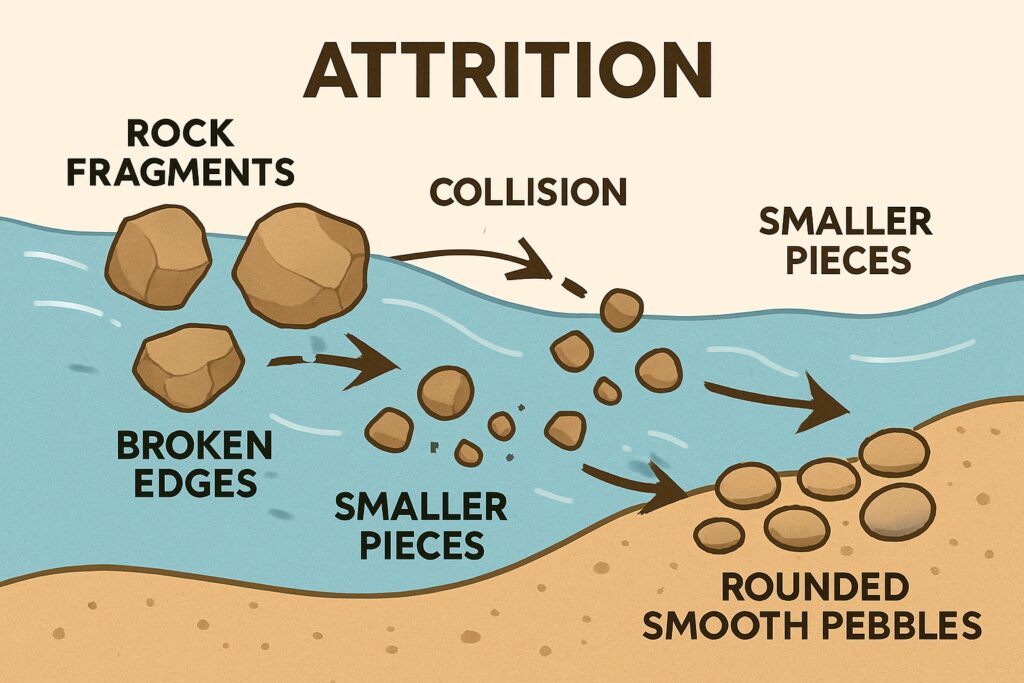
Transportation
Rivers carry bits of rocks and soil from one location to another.
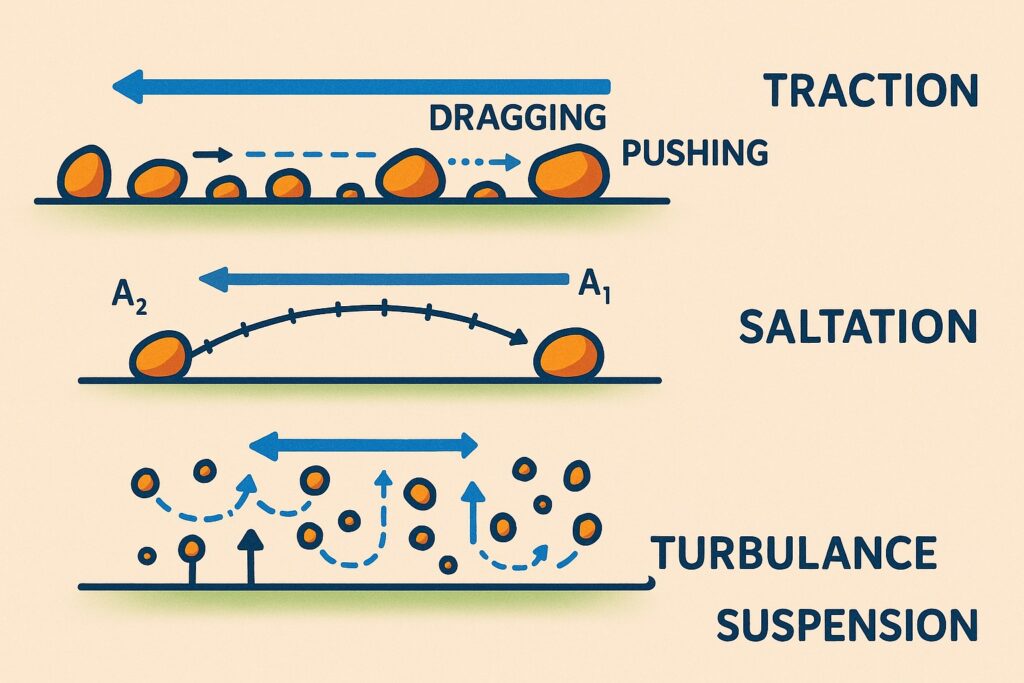
This process is called transportation and happens in four main ways:
- Traction
- Big, heavy rocks like pebbles roll and drag along the riverbed.
- These move slowly and stay at the bottom.

- Traction
- Saltation
- Medium-sized pieces bounce or hop along the riverbed.
- Think of them like little jumps in water!
- Suspension
- Tiny particles like silt and mud float in the water.
- These make the river look muddy.
- Solution
- Some minerals dissolve in the river water, just like sugar in tea.
- You can’t see them, but they’re there.
Deposition
When a river flows from the hills into flatter land, its slope becomes gentle. This causes the river to slow down. When that happens, the river can’t carry all the rock and soil (its load) anymore—so it starts dropping it. That’s what we call deposition.
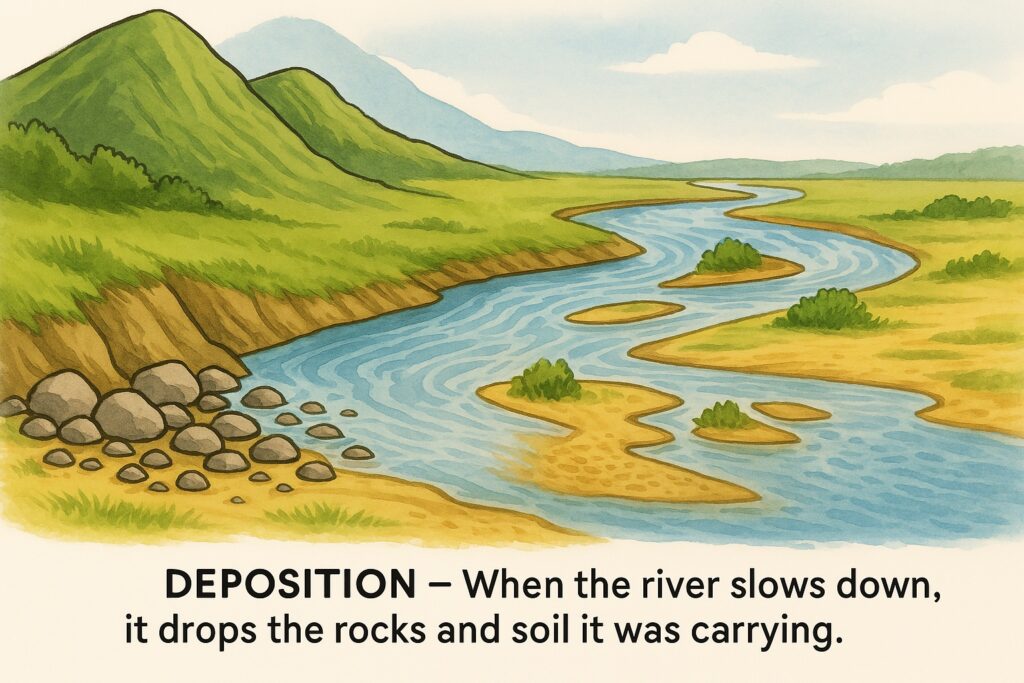
Stages of River
Upper Course (Youth Stage)
- Happens in mountainous regions
- River moves very fast and cuts deep into the land
- This creates deep, narrow valleys called V-shaped valleys
- You also find:
- Gorges (very deep valleys with steep sides)
- Canyons (extra deep gorges, like the Grand Canyon)
- Waterfalls, rapids, and cataracts (where the river tumbles quickly)
Middle Course (Maturity Stage)
- River flows through gentler slopes
- It collects water from tributaries, becoming wider and deeper
- Slows down a little, so it starts to transport more sediments
- Makes meanders—bendy, loop-like curves in the river
- Also forms alluvial fans—fan-shaped deposits made where steep rivers hit flat land
Lower Course (Old Age Stage)
- Happens on flat plains near the sea or lake
- River is wide, calm, and full of materials
- Hardly any erosion now
- Lots of deposition happens:
- Flood plains are created during floods
- Braided streams form when the river splits into many small channels
- Levees are natural raised banks along the sides
- Oxbow lakes form when a meander gets cut off
- Deltas form where rivers empty into seas, leaving behind rich soil
- Estuaries (if no delta forms) are wide mouths of rivers mixing with seawater
Underground Water
When it rains:
- Some water flows into rivers or evaporates into the air
- But some water soaks into the ground—this is called underground water
Types of Rocks and Water Flow
- Permeable rocks (like sandstone): These have small gaps that let water pass through easily.
- Impermeable rocks (like granite): These don’t allow water to pass through—unless they have cracks.
What Is the Water Table?
- The water table is the top level where underground rocks are completely filled with water.
- Rocks that hold water are called aquifers.
- The area where water fills all the gaps in rocks is the zone of saturation.
What Are Wells and Tube Wells?
- A well is a hole dug by humans into the ground to bring up underground water.
- A tube well is like a well but dug using machines, usually deeper and narrower.
- Both reach down to the permanent water table, so they usually supply water all year round.
What Is an Artesian Well?
An artesian well is special—the water comes up automatically without using a pump!
This happens because:
- Water is trapped between two layers of impermeable rocks
- The rock in between (called an aquifer) has pressure from above
- If a hole is made into the layer, water shoots up on its own
What Is a Spring?
A spring is a spot where groundwater naturally flows out from the earth’s surface. This happens when:
- The water stored underground finds a way to escape through a crack or opening
- It flows out under natural pressure
- It’s like the Earth has a little tap, and when it’s full, the water comes pouring out!
What Are Hot Springs?
- Sometimes, the underground water comes into contact with hot rocks or steam
- This makes the water warm or hot when it reaches the surface
These are called hot springs and are common in volcanic or mountain regions
Examples in India:
- Manikaran (Kullu Valley)
- Tatapani (near Shimla)
- Sohna (Haryana)
- Rajgir & Sitakund (Bihar)
What Are Geysers?
- A geyser is a special kind of hot spring
- It shoots out boiling water and steam like a fountain at intervals
- This happens because of pressure build-up from hot gases underground
How Does Underground Water Shape the Earth?
Just like rivers shape the surface, underground water changes the land below. It:
- Erodes rocks
- Carries the material away
- Deposits new formations
This is especially common in limestone regions, creating what’s called Karst Topography.
